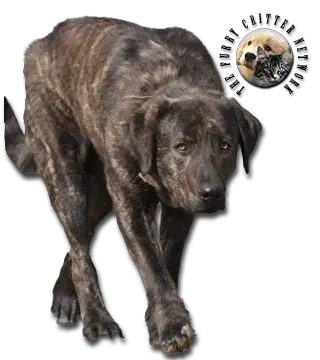Breed Standard
Head: Medium size, dry, no wrinkles. Stop not pronounced. Long, b, straight nose bridge. Powerful jaws.
Ears: Medium size, slightly thick, almost triangular with rounded tips, drop.
Eyes: Set obliquely in the skull. Medium size. Light brown color in light-coated varieties and dark brown in dark-coated varieties.
Body: Rectangular. Short neck without dewlap. Broad, deep chest. Broad, short, muscular loin. Croup slightly sloped. Narrow through the belly.
Tail: Thick and bushy, carried in the shape of a saber, reaching the hock joint.
Hair: Thick, coarse, short, 5 cm (2 in), harsh, close-lying, and smooth. No undercoat.
Coat: Wolf gray most common. Any shade of gray, with or without a black mask; brindle.
Size: Dog: 55 to 60 cm. (21.5-23.5 in).Bitch: 52 to 57 cm. (20.5-22.5 in).
Weight: Dog: 30 to 40 kg. (66-88 lb).Bitch: 20 to 30 kg. (44-66 lb).
History
Modern genetic studies have shown that the modern breed is unique from other similar breeds in Portugal.
It is said to be "ferocious against wolves."
With the eradication of wolves and other large predators the Castro Laboreiro Dog lost its original use. Changes in agricultural methods over the last hundred years led to many of these dogs being abandoned, turning feral and becoming a problem for those that raise cattle and horses.
Today, the breed has mostly been removed from its native range and purpose, and is kept as a companion and guard dog. It was first exhibited at a dog show in 1914, and the first written breed standard was by veterinarian Manuel Marques in 1935, when the breed was recognised by the Clube Portugues de Canicultura, the official Federation Cynologique Internationale (FCI) kennel club for Portugal founded in 1897. It is also recognised, under its Portuguese name, by the United Kennel Club in the United States, in their Guardian dog group. It may also be listed under the name cão de Castro Laboreiro, similar-sounding names, or different English versions of the name (such as Portuguese cattle dog or Portuguese watchdog) by large commercial breeders, minor kennel clubs that require little to no breed verification for registration, and Internet-based dog registry businesses, where it is promoted as a rare breed for those seeking a fashionably novel or unique pet. Nevertheless, the number of specimens of this breed does not exceed 500 in the whole world. In Portugal, there are a half-dozen breeders, plus a couple more elsewhere in Europe (in United Kingdom and Germany), and one in the US.
Behavior
This robust, loyal, docile breed is affectionate, calm, and even-tempered. Constantly on the alert, this dog's great courage and wariness of strangers make him a superb guard dog. Firm training is required.
The Portuguese Cattle Dog needs exercise and room to run. Regular brushing is required.
Function
Herder, Guard Dog, Police Dog, Pet.
Health
Health issues specific to the breed have not been documented. Dogs represented as Castro Laboreiros may be mixed with other breeds, which may have other genetic health problems. Puppy buyers should enquire of breeders about types of health testing done on the sire and dam; responsible breeders will be able to provide information. Being a "rare breed" does not guarantee immunity from inherited disease or disability.






